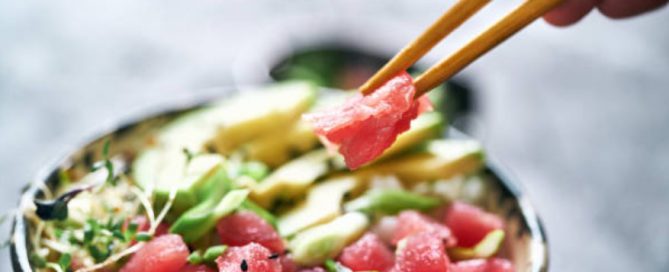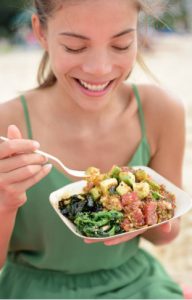In Search of the Island’s Best Poke

Poke popularity has expanded far past the shores of Hawaii to become one of the hottest food trends across America. If you haven’t tried poke yet, Maui is the best place to get started. Native Hawaiian and Asian influences are strong for this appealing tropical dish. There are many tasty recipes to try around the island, or build your own with simple local ingredients. The word poke (pronounced "POH-keh.") in Hawaiian means “to slice or cut,” and in this context refers to raw fish, usually ahi tuna. This main ingredient may be sprinkled with seasoning or marinated. There are a plethora of complimentary sliced up ingredients to mix in with the fish, and it may be served over rice as a meal in a bowl. If you haven’t tried poke yet, Maui is the best place to get started. Our native Hawaiian and Asian influences are strong. There is an abundance of fish in the waters around Maui, so this key ingredient is the freshest here. We’ve listed some of our favorite local spots for first-timers or poke experts. But first, we break down this island staple.
Poke Ingredients and Pairings
Base protein: The most common poke central ingredient is sushi-grade yellowfin ahi tuna. The raw fish has enough firm texture, but is still delicate enough to be easily chewed easily, and has a wonderful flavor. However, you may see other raw fish offered, including salmon and snapper. Try and determine if the poke you are ordering is fresh from the islands (salmon will not be). There are also cooked options, or a combo dish, that may include tofu or “crab salad” which is actually cooked fish in a seasoned mayo dressing. However, ahi poke is definitely the most common, and for good reason- it’s delicious! Local snapper is also great, but can be more expensive. Rice: Many dishes and bowls come with a base layer of white sticky rice, another island staple. Sticky rice is made with a short grain white rice, usually Calrose. If you like a looser rice, Jasmine has a nice subtle complementary flavor. Kama'aina will often make a big batch of rice, and use it for many dishes. The basic sticky rice recipe simply uses less salted water in the rice cooker. If the rice is also going to be used for sushi, recipes call for a wee bit of sugar and vinegar after cooking. With healthier options in mind, more places are offering brown rice, which can give the dish a nuttier flavor. Other bases are not as popular here as you might find on the mainland, such as zucchini noodles. We are poke purists, lol. This website has a traditional sushi rice recipe that is just like our favorite’s auntie’s method, and will make a good base for poke dishes and roll your own sushi at home. Vegetables: As chef’s get more creative, you’ll find more and more veggies accompanying the fish cubes. Traditional island toppings include avocado, shaved or pickled onion, green onion, edamame (soy beans), ogo (seaweed), egg and cucumber.
Dressing: Shoyu (soy sauce) based sauces are common, which may be combined with sesame oil, rice vinegar or fresh lemon and used as a marinate for the fish or drizzled on top. Thicker drizzles may combine mayo and/or avo with chili oil, but the most common spicy seasoning for creamy or shoyu sauces is wasabi.
Seasonings and toppings: The cubes of fish can be mixed with scallions, chopped cabbage, ginger, toasted sesame seeds, flakes of Ume (dried plum), garlic and pink sea salt to enhance the flavor. Crispy fried onion is a popular topping, mmm, yummy!
Note on consuming raw fish: Seafood is a highly regulated industry in Hawaii, with strong emphasis on safety. While the chance of illness is rare from a reputable establishment or food store, anywhere that sells or serves raw fish for consumption must display a Department of Health advisory stating that eating raw or undercooked fish increases your chance of food borne illness, and people with certain health risks should avoid this. There are certain types of fish that pregnant women, nursing mothers and children should avoid.
We like purchasing grocery store poke at Foodland, as much of their poke selection is sourced locally. Fresh caught fish is at a slightly higher price. Other selections that have been frozen have the advantage of preserving the fish from breaking down before it is thawed and sold, and reducing the risk of pathogens. Another good choice is Whole Foods. They go to great lengths to ensure fish is responsibly sourced and handled.
Out of an abundance of caution, we eat our store poke the same day or next day, but then fully cook any remaining fish the evening of day two through day three, and use in island-style tacos. As tempting as it may be price wise, avoid buying roadside “fresh caught fish” and consuming reef fish.
Vegetables: As chef’s get more creative, you’ll find more and more veggies accompanying the fish cubes. Traditional island toppings include avocado, shaved or pickled onion, green onion, edamame (soy beans), ogo (seaweed), egg and cucumber.
Dressing: Shoyu (soy sauce) based sauces are common, which may be combined with sesame oil, rice vinegar or fresh lemon and used as a marinate for the fish or drizzled on top. Thicker drizzles may combine mayo and/or avo with chili oil, but the most common spicy seasoning for creamy or shoyu sauces is wasabi.
Seasonings and toppings: The cubes of fish can be mixed with scallions, chopped cabbage, ginger, toasted sesame seeds, flakes of Ume (dried plum), garlic and pink sea salt to enhance the flavor. Crispy fried onion is a popular topping, mmm, yummy!
Note on consuming raw fish: Seafood is a highly regulated industry in Hawaii, with strong emphasis on safety. While the chance of illness is rare from a reputable establishment or food store, anywhere that sells or serves raw fish for consumption must display a Department of Health advisory stating that eating raw or undercooked fish increases your chance of food borne illness, and people with certain health risks should avoid this. There are certain types of fish that pregnant women, nursing mothers and children should avoid.
We like purchasing grocery store poke at Foodland, as much of their poke selection is sourced locally. Fresh caught fish is at a slightly higher price. Other selections that have been frozen have the advantage of preserving the fish from breaking down before it is thawed and sold, and reducing the risk of pathogens. Another good choice is Whole Foods. They go to great lengths to ensure fish is responsibly sourced and handled.
Out of an abundance of caution, we eat our store poke the same day or next day, but then fully cook any remaining fish the evening of day two through day three, and use in island-style tacos. As tempting as it may be price wise, avoid buying roadside “fresh caught fish” and consuming reef fish.
The Best Places to Eat Poke
 Monkeypod Kitchen
Go for the Poke Tacos on the appetizer menu, but also try their fabulous Mai Tai with likikoi foam. They also serve a nonalcoholic version! Located in Wailea and Kaanapali.
Tin Roof
Not showing on the online menu, their Ahi Poke Bowl has been available each time we've gone in, which is a lot! This casual spot central Maui spot has a line at peak lunch time for a reason- call ahead for an order to go!
Like Poke? Food Truck
Who could resist a business name like this? There is straightforward Poke (shoyu sauce, onion on cabbage and rice), but when the stars align, this mobile stop has incredible Hurricane Fried Poke. Check the link for their current central Maui location.
Ocean Vodka
In addition to an outstanding view, this remote upcountry location has Ocean Poke Nachos. If you like fresh ingredients, these are like a party in your mouth. Note the cafe is open 11am to 7pm only. Ocean Vodka is also a distillery (with tours), so expect a wide range of creative cocktails on the menu too.
Foodland
This island grocery store chain is the go to for Poke. It's made fresh daily, with a full row of flavor choices to try out. The combo of warm rice topped with your choice of cold poke makes a great to-go lunch. Click the Foodland link for recipes to make with their poke.
Monkeypod Kitchen
Go for the Poke Tacos on the appetizer menu, but also try their fabulous Mai Tai with likikoi foam. They also serve a nonalcoholic version! Located in Wailea and Kaanapali.
Tin Roof
Not showing on the online menu, their Ahi Poke Bowl has been available each time we've gone in, which is a lot! This casual spot central Maui spot has a line at peak lunch time for a reason- call ahead for an order to go!
Like Poke? Food Truck
Who could resist a business name like this? There is straightforward Poke (shoyu sauce, onion on cabbage and rice), but when the stars align, this mobile stop has incredible Hurricane Fried Poke. Check the link for their current central Maui location.
Ocean Vodka
In addition to an outstanding view, this remote upcountry location has Ocean Poke Nachos. If you like fresh ingredients, these are like a party in your mouth. Note the cafe is open 11am to 7pm only. Ocean Vodka is also a distillery (with tours), so expect a wide range of creative cocktails on the menu too.
Foodland
This island grocery store chain is the go to for Poke. It's made fresh daily, with a full row of flavor choices to try out. The combo of warm rice topped with your choice of cold poke makes a great to-go lunch. Click the Foodland link for recipes to make with their poke.
Go Local Loco with Hurricane Style Poke
Here is an island favorite, and the best way to "dress up" your store bought poke. What you’ll need: 1 lb. of your favorite flavor poke from Foodland 1/2 cup kaki mochi (in the store's snack/candy aisle) 3 T furikake (seasoning typically made with toasted sesame seeds, nori seaweed, salt, sugar you can buy in the spice aisle) Crush kaki mochi into smaller pieces (not fine crumbs). Sprinkle on poke, then sprinkle with furikake. Note: Furikake has salt as the first ingredient, so avoid starting with a salty poke flavor like Traditional Hawaiian. Some hurricane recipes call for a dusting of li hing mui powder (sweet and salty dried plum seed), but this ingredient is hard to find without aspartame, so we didn't include it. You are now prepared for your full culinary tour of poke while on Maui!January 27th, 2023 | Uncategorized




